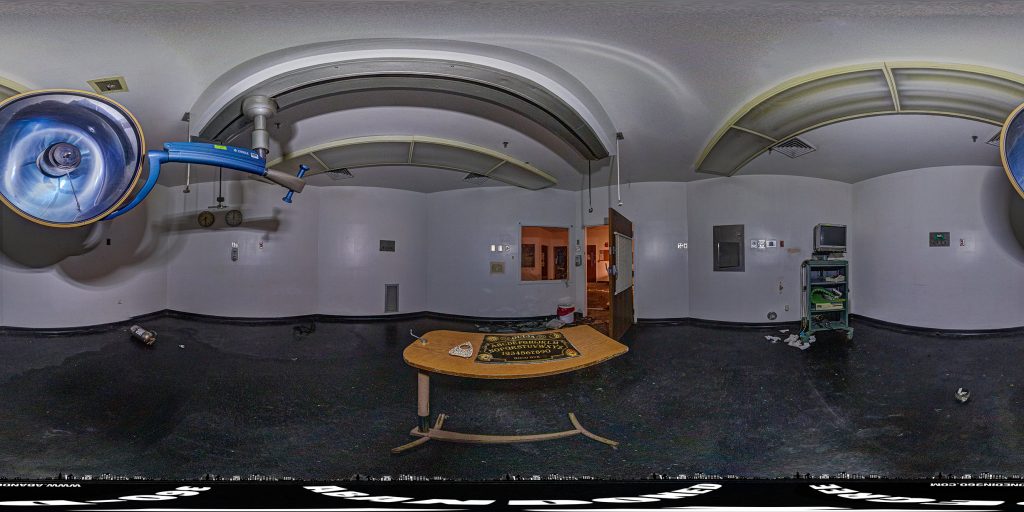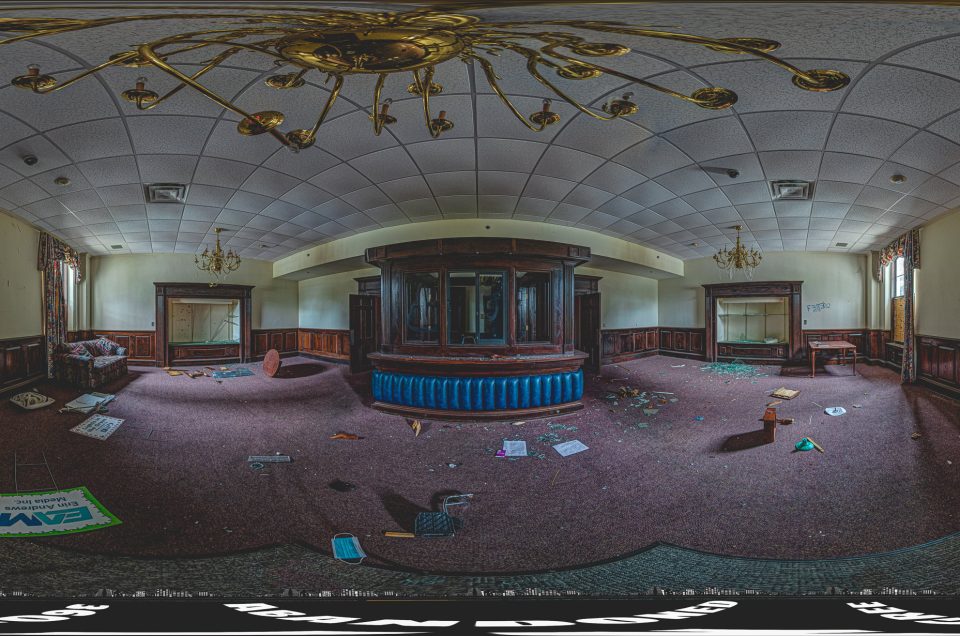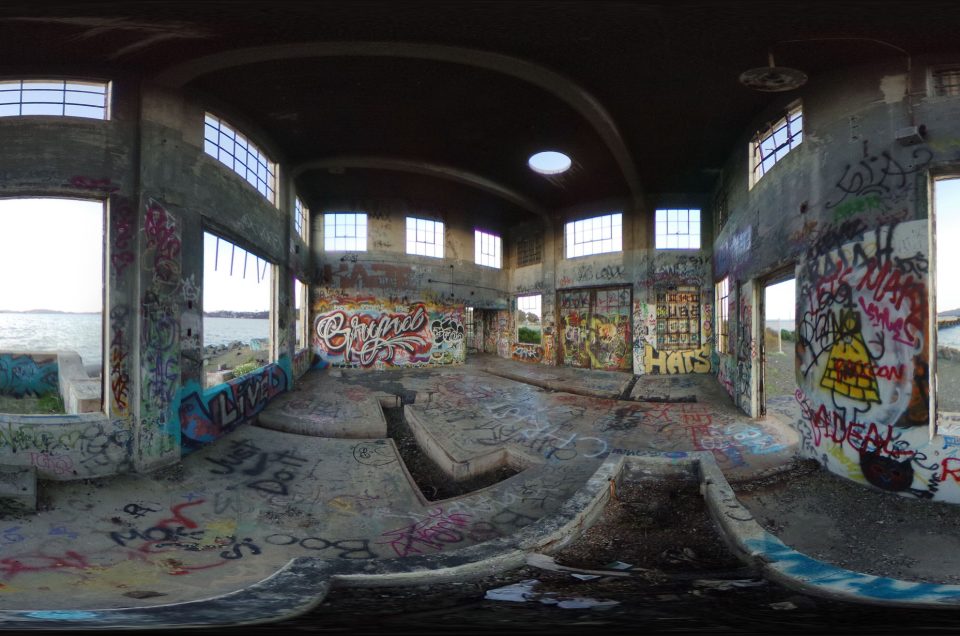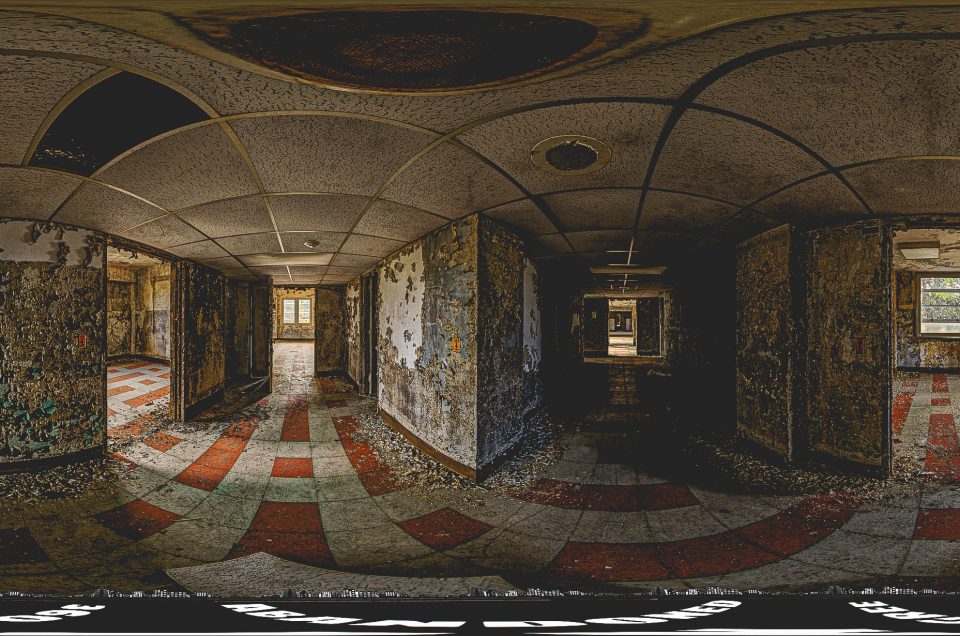Exploring the Abandoned Lower Oconee Community Hospital in Georgia
Step inside the story of Lower Oconee Community Hospital in Glenwood, Georgia—an abandoned rural facility that still echoes with the routines of shift changes and the quiet urgency of small-town care. For urban explorers, its corridors, exam rooms, and waiting areas offer a compelling look at how a community’s lifeline can fade yet remain remarkably intact, from scattered charts to faded directional signage.
Use the self-guided, 15-image, 360-degree panoramic virtual tour below to move room to room at your own pace. Whether you’re documenting decay, studying layouts, or simply seeking the atmosphere of a shuttered medical center, Lower Oconee Community Hospital delivers a vivid, immersive experience tailored to the URBEX community.
Click here to view it in fullscreen.
If you’re fascinated by urban exploring in Georgia, one site that surely sparks intrigue is the Lower Oconee Community Hospital in Glenwood. This small rural hospital – built in 1960 and opened in the early 1960s – was once a lifeline for the community. Originally known as Wheeler County Hospital, it served local residents for decades, providing emergency medical care and inpatient services to people in Wheeler County and neighboring areas. Today, it lies abandoned in Georgia, its halls empty and its future uncertain. In this adventurous yet informative journey, we’ll explore the rise and fall of Lower Oconee Community Hospital – from its proud beginnings and years of service to the struggles that led to its closure and abandonment. Along the way, we’ll uncover its historical significance, the reason it was left to decay, and what makes this forsaken hospital a compelling URBEX destination for urban explorers.
A Community Lifeline is Born (1960s–1980s)
Lower Oconee Community Hospital was born out of a community’s need for accessible healthcare in rural Georgia. In the late 1950s, local citizens of Glenwood and Wheeler County rallied to establish a hospital of their own. They helped raise funds to match government grants so that a modern medical facility could be built in their small town. These efforts bore fruit when construction finished in 1960, and the hospital opened its doors in the early 1960s. At that time it was known as Wheeler County Hospital – a humble, county-owned facility dedicated to serving the healthcare needs of this rural region.
In its early years, the hospital was modest but well-equipped for a small community. It featured an emergency room, operating suites, a maternity/women’s health ward, and patient rooms for those needing to stay overnight. There was even a tiny intensive care unit for serious cases, reflecting the hospital’s mission to provide “care for all” who came through its doors. With around 25 to 40 beds available (the exact number grew over time as the facility expanded), the hospital was prepared to handle everything from routine check-ups to urgent emergencies. Importantly, no one was turned away for inability to pay – like many rural hospitals, Lower Oconee often treated uninsured patients out of necessity and compassion.
Community support remained strong through the 1960s and 1970s. Local families depended on the hospital for births, surgeries, and lifesaving interventions. The hospital was a point of pride – a tangible symbol that Glenwood might be a small town but had big heart when it came to caring for its people. In the mid-1980s, the facility underwent an expansion and modernization. A new wing was added, boosting capacity (at one point it could accommodate up to 40 patients at once) and updating medical equipment. By this time, management of the hospital had shifted; around 1980 it was sold to a private corporation and rebranded as Lower Oconee Community Hospital. The new name reflected a broader mission beyond just Wheeler County, invoking the Oconee River region that Glenwood is part of. Despite the change in ownership, the hospital’s role remained the same: to be a healthcare lifeline for rural residents who otherwise had to travel long distances for care.
During its heyday, Lower Oconee Community Hospital was more than just a building with doctors and nurses – it was the heartbeat of Glenwood. As the only hospital in Wheeler County, it served not only Wheeler’s ~8,000 residents but also folks from neighboring Telfair County. (Telfair’s own hospital in McRae closed in 2010, making Lower Oconee even more crucial for that area.) The hospital’s emergency department meant an ambulance didn’t have to drive 30+ miles to the next nearest ER in cities like Vidalia or Dublin for every urgent case. In fact, Lower Oconee was strategically vital – the next closest hospitals in any direction were about 30–45 minutes away, a long haul in a life-or-death situation.
The hospital also had an interesting tie to the local economy beyond civilian patients. It provided medical support to the Wheeler Correctional Facility, a large prison in the county. The prison had its own clinic for basic care, but for things like X-rays, lab tests, or emergencies beyond their scope, they relied on the hospital in Glenwood. This partnership underscored how ingrained the hospital was in the fabric of the community – it served everyone from newborns and grandparents to even inmates when needed.
By the late 1980s, Lower Oconee Community Hospital seemed to be on solid footing. It had grown in capacity and was firmly established as a hub of healing in Glenwood. However, beneath the surface, challenges were brewing that would, decades later, threaten the hospital’s very existence. Changing demographics, economic hardships, and the harsh economics of rural healthcare were slowly catching up with this beloved institution.
Storm Clouds: Financial Struggles in a Changing Era (1990s–2000s)
Like many rural hospitals across America, Lower Oconee began to face headwinds in the 1990s and 2000s. The hospital’s troubles didn’t appear overnight – rather, they mounted gradually as the healthcare landscape evolved. Glenwood’s population was small and aging, and many patients either lacked health insurance or were covered by Medicaid/Medicare (which often reimburse at lower rates than private insurance). In fact, by the 2010s Wheeler County had an uninsured rate of over 20% and high poverty – factors that made it hard for the hospital to break even. Providing care to everyone who needed it, regardless of ability to pay, had always been a moral imperative for the hospital, but it came at a steep financial cost. Hospitals incur “bad debt” for unpaid bills, and Lower Oconee was accumulating a lot of it over time.
Management issues also began to plague the facility. Longtime community members recall that the hospital went through multiple ownership and leadership changes in the 1990s and early 2000s. The county had sold it in 1980 to private owners, and it appears the hospital may have been sold again or managed by different companies in later years. Each transition brought disruption. There were periods of mismanagement and cash flow problems, as described by local officials looking back. By the late 2000s, the hospital’s budget was in the red, and talk of possible closure started surfacing. The very idea was unthinkable to residents who had fought to keep their hospital open. In the 1990s, townspeople had even protested at council meetings when rumors of closing swirled, and a larger regional healthcare provider briefly stepped in to help stabilize the situation. For a time, these efforts kept Lower Oconee afloat – the hospital hung on through lean years, defying the odds that were shuttering other rural hospitals.
Behind the scenes, however, the debt continued to grow. By the early 2010s, the hospital was reportedly sinking under the weight of debts it owed. The facility simply wasn’t seeing enough paying patients to cover the high fixed costs of running a hospital (staff salaries, equipment, maintenance, etc.). Wheeler County’s population was declining and aging, meaning fewer privately insured patients and more on Medicare/Medicaid or uninsured. At the same time, the hospital’s buildings and equipment were aging too – costly upgrades were needed to meet modern standards, but money was tight. Rural hospitals like Lower Oconee also struggled to recruit doctors and specialists, which meant offering fewer services and losing potential patients to larger hospitals in bigger towns. It was a vicious cycle common to many small hospitals abandoned in Georgia and across the country in recent years.
By 2013, the situation had become dire. The hospital’s administrators were openly warning that they could not keep operating under the current conditions. Jimmy Lewis, CEO of an association of rural Georgia hospitals, later explained that Lower Oconee suffered from high rates of uninsured patients and costly administrative burdens, creating “a very, very bad cash-flow situation.” All the warning signs were flashing red: the hospital was on the brink of running out of money.
Collapse and Closure: The End of an Era (2014)
The breaking point came in early 2014. In February of that year, Lower Oconee Community Hospital abruptly shut its doors, stunning the community. The hospital’s CEO at the time, Karen O’Neal, announced that the facility had to “suspend operations” due to being in dire financial straits. It was revealed that the hospital simply did not have sufficient volume of patients to support its expenses. Costs had outrun income for too long, and debts were piling up with no rescue in sight. Contributing to the immediate crisis, Medicare funding for the hospital had been cut off – a result of billing and compliance issues that left the facility unable to get reimbursed for some of its services. With major revenue streams suddenly frozen, the hospital could no longer make payroll or pay suppliers.
On that bleak day in February 2014, roughly 100 hospital employees were laid off as the institution closed. Glenwood’s mayor and residents were in disbelief; their small-town hospital, which had weathered so many storms, had finally flatlined. Lower Oconee’s February 2014 shutdown marked the fourth rural hospital closure in Georgia within a two-year span, underscoring a wider rural healthcare crisis in the state. The hospital’s leadership said they were looking to “restructure” and possibly reopen in some form (even considering conversion to an urgent care center), but nothing was certain.
A glimmer of hope appeared just a few weeks later. In March 2014, a new owner came forward with a plan to buy and reopen Lower Oconee Community Hospital. This was Norman King, a healthcare executive who had once worked at the hospital and now headed a company called Charlton Healthcare Corp. King purchased the shuttered hospital in hopes of reviving it, and by the first week of March 2014 he reopened the facility under new management. Staff were called back to work (though King noted he would likely operate with about 80 employees instead of the previous 120). For the community, it felt like a second chance – the emergency room lights flickered back on, and ambulances could once again bring patients to Glenwood.
However, this revival proved painfully short-lived. Despite King’s best efforts, the hospital couldn’t escape its financial quagmire. By June 2014 – less than four months after reopening – Lower Oconee Community Hospital closed yet again, the victim of a second financial collapse in a single year. A sign was posted on the hospital door in late June stating that “hospital operations have been suspended” and that the facility would “reopen in the very near future under reorganization.” But that optimistic tone belied the turmoil inside. It emerged that several doctors and staff hadn’t been paid in weeks leading up to the June shutdown. The new owner, Mr. King, reported that Medicare payments had still been on hold and the hospital was starved of cash. In a letter to state officials, King explained that the closure was due to lingering financial problems stemming from before his acquisition – essentially, the hospital was too deeply in debt to recover quickly.
The June 2014 closure felt like deja vu, and it devastated Glenwood all over again. Once more, the town was left without local emergency care, forcing residents to travel 25–45 minutes to the nearest hospitals for help. Wheeler County ambulance services had to adjust; in one incident, paramedics resorted to driving a heart attack patient in a personal vehicle part of the way to meet another county’s ambulance because theirs was already on a call. Such stories underscored the life-and-death stakes of losing the hospital.
For the remainder of 2014 and into 2015, Lower Oconee Community Hospital sat mostly silent. Its license was placed on “inactive status” pending reorganization. There were flickers of activity – occasional talk of new investors or converting the hospital into a freestanding emergency department under a new state program – but nothing concrete materialized immediately. To outsiders, it looked as if the hospital had flatlined for good in 2014, but behind the scenes Norman King and others were still trying to find a way to revive it one more time.
Final Attempts and Permanent Abandonment (2015–2016)
By early 2016, Glenwood’s hospital had been mostly closed for over a year, save for that brief 2014 revival. The community’s needs hadn’t gone away, though, and neither had the dream of saving the hospital. In February 2016, Norman King mounted one last effort to reopen Lower Oconee. He restructured operations under his company and arranged for the hospital to regain its critical access hospital designation (a special status for rural hospitals with 25 beds or fewer). Plans were announced to reopen on March 1, 2016. Indeed, for a short period in 2016, it seemed the hospital had a pulse again – staff were rehired, and the facility was prepared to receive patients under the new management.
Tragically, fate (and finances) had other ideas. A combination of regulatory setbacks and cash shortages thwarted this final restart. During a severe winter storm in early 2016, the hospital had to temporarily divert patients to other facilities, which led to issues with its Medicare provider number. The government reimbursement process was disrupted at a critical moment, freezing the hospital’s ability to collect on about $3 million of owed payments. With bills coming due and payroll to meet, this cash flow crisis proved insurmountable. By the summer of 2016, Lower Oconee Community Hospital’s last incarnation failed – the remaining employees were laid off and the hospital closed permanently under King’s tenure in mid-2016.
This time, there were no promises of “reopening soon.” The doors were locked, and the building was left to the elements. The final closure marked the end of an era: after roughly 56 years of operation (1960–2016), Glenwood’s lone hospital was no more. The impact on the community was profound and sobering. “It’s been devastating,” said Glenwood’s longtime mayor, reflecting on the hospital’s demise and the toll it took on the town. Not only was healthcare now far away for residents, but the hospital had been one of the county’s largest employers – roughly 120 jobs were lost by the final closure, in a county already struggling with poverty.
In the aftermath, there was even a legal saga that added a dark footnote to the hospital’s story. In 2018, Norman King – the last owner who tried to save the hospital – was indicted on 44 counts of theft amid allegations that he had collected insurance premiums from hospital employees but failed to pay the insurers, letting their policies lapse. It was a complicated case tied up in the financial chaos of the hospital’s final days. As of 2024, that case was still winding through the courts. For many in Glenwood, it was painful to see their hospital’s legacy tangled in criminal indictments, but it only reinforced how much turmoil had surrounded the facility’s collapse.
Once the flurry of news around the closure died down, the Lower Oconee Community Hospital building entered a new chapter: years of quiet abandonment. By late 2016, the halls that once bustled with nurses and patients fell silent. The property owner (King’s company or its creditors) secured the site, and the hospital joined the sad roster of shuttered rural hospitals that dot the map of Georgia.
Glenwood’s Loss and the Hospital’s Legacy
The closure of Lower Oconee Community Hospital was not just a blow to healthcare access – it struck at the heart of Glenwood’s identity. For decades, the hospital had been a point of stability and pride, so its loss triggered a downward spiral in the community. After the hospital shut down in 2014 and again in 2016, other mainstays of the town began to follow. Within a couple of years, Glenwood saw its only bank close, its sole pharmacy shut down, and even the county’s only grocery store went out of business. The hospital’s disappearance removed foot traffic and economic activity that those businesses relied on. On Glenwood’s once quaint Main Street, storefronts started emptying out one by one. “Building after building is now for sale, closing, or falling apart,” a journalist noted of the town’s decline, painting a picture of creeping blight with weeds growing through cracked foundations.
The hospital had been not only Wheeler County’s primary healthcare provider but also one of its largest employers. When it closed, it was as if a factory had shut down – families lost stable jobs, and young people had yet another reason to leave town in search of opportunities elsewhere. Glenwood’s mayor, G.M. Joiner, who served over 30 years, publicly doubted whether the town would ever recover from this economic and social gut punch. His pessimism is understandable: with 39% of the county’s population living in poverty and few other industries (besides a large prison) in the area, losing the hospital meant losing a cornerstone of the community’s fragile infrastructure.
Beyond the economics, there’s an emotional and psychological impact when a community loses its only hospital. Residents suddenly feel less secure – a basic safety net has been removed. One local EMS director estimated that a few lives each year were likely lost in Wheeler County as an indirect result of the longer emergency response times without a local hospital, noting that those lives “sure meant something to those folks’ families.” It’s a chilling thought: a hospital closure translating to real human lives that might have been saved.
The legacy of Lower Oconee Community Hospital thus carries a mix of pride and sadness. On one hand, it stood for decades as a testament to what a small town could achieve – Glenwood kept its hospital running far longer than many thought possible, thanks to community support and determined staff. Generations of local families were born, healed, or comforted within its walls. On the other hand, its ultimate fate highlights the vulnerabilities of rural healthcare in modern America. The story of Glenwood’s hospital became a cautionary tale cited in state and national conversations about rural hospital closures. It illustrated how factors like high uninsured rates, Medicaid funding cuts, economic downturns, and policy decisions (such as Georgia’s choice not to expand Medicaid under the Affordable Care Act) all woven together to create a crisis that not only shuttered hospitals but also threatened to turn some communities into ghost towns.
For Wheeler County, the hospital’s closure truly felt like “the end of an era.” Yet, the building itself still stands – an ever-present reminder of the community’s loss, visible to anyone driving down North 3rd Street in Glenwood. It’s an eerie sight for locals who remember the busy days; the parking lot that once saw a constant flow of patients and visitors is now often empty, occasionally gated or overgrown at the edges. The hospital’s name is still emblazoned on the exterior, though the letters may be fading. It sits in silence, day after day – a physical piece of history frozen in time.
The Hospital as an Urban Exploration (URBEX) Destination
In recent years, the forlorn Lower Oconee hospital building has drawn the attention of a different group of people: urban explorers. Urban exploration (URBEX) enthusiasts are intrigued by abandoned structures, and an abandoned hospital in Georgia with such a storied past is a tempting target. Driving up to the site, an explorer would see a low-slung, concrete-and-brick facility typical of mid-20th-century architecture. The design is utilitarian, with a flat roof and a central entrance bay that once welcomed emergency vehicles and patients. Weeds poke through cracks in the pavement, and the once well-kept landscaping has grown wild. On quiet evenings, the building’s exterior can take on a haunted visage – dark windows reflecting the twilight, paint peeling around the frames, and maybe a stray curtain fluttering if a breeze sneaks through a broken pane.
For those passionate about urban exploring in Georgia, places like Lower Oconee Community Hospital hold a powerful allure. Stepping into an abandoned hospital is like entering a time capsule of the moment it was deserted. There’s a sense of walking in the footsteps of doctors and patients from years past. One might find faded signs pointing to the maternity ward or x-ray lab, wheelchairs left in hallways, or even old medical records strewn about (though any valuable equipment was likely removed or sold off when the hospital closed). Graffiti and signs of vandalism may mar some walls – unfortunately a common fate of accessible abandoned sites – and the smell of mildew and decay permeates the air. In some rooms, ceiling tiles have fallen to the floor, and the Georgia humidity has allowed black mold to creep over surfaces where roof leaks let water in. The once-sterile white corridors are now tinged green with algae and moss near the broken windows, truly giving it an apocalyptic atmosphere.
Urban explorers often describe visiting such a site as both exhilarating and somber. Exhilarating, because there’s an adrenaline rush in poking around a place that is off-limits and long forgotten by society. Somber, because unlike a purely industrial ruin, an abandoned hospital carries the ghostly weight of human stories – lives saved and lost, babies born, pain alleviated – all now just echoes in empty rooms. In Lower Oconee’s case, the relatively recent closure means many locals still remember it vividly. An explorer might stumble upon personal touches that drive that home, like family thank-you cards pinned on a bulletin board in an empty nurses’ station, or an outdated calendar on the wall showing June 2014, the month the hospital closed for good. These artifacts create a narrative for those who wander inside: you can almost imagine the hurry of the last days, when staff left and never returned, leaving calendars and bulletin boards frozen on that final chapter.
As an URBEX site, Lower Oconee Community Hospital offers a rich blend of history and atmosphere. It’s not a famous landmark, so it retains a degree of secrecy and solitude that many explorers appreciate – you won’t typically run into crowds of tourists here. However, it has garnered mentions in urban exploration circles as a noteworthy spot. Photographers are especially drawn to the hospital’s surgical suites and patient rooms, where nature’s encroachment juxtaposes eerily with remnants of medical technology. An operating room light, for instance, might still hang from the ceiling, now rusted and dull, illuminating nothing but emptiness. In the dim light filtering through broken blinds, a row of hospital beds might be seen covered in dust, resembling a post-attack scene from a horror movie. Every corner offers a new discovery: the old cafeteria with chairs overturned, the reception desk with a phone that will never ring again, and the emergency room bay where ambulances once delivered the injured – now quiet except for the occasional drip of water from a leak.
Exploring this abandoned Georgia hospital truly feels like stepping onto another planet for a moment. It’s a place where time stopped nearly a decade ago, and all that’s left is the shell of what was. For some urbex adventurers, visiting provides an opportunity to document the building’s condition and preserve its memory through photographs. There’s an understanding that such places won’t last forever – nature and weather will eventually reclaim them. In fact, each passing year leaves the structure weaker; parts of the roof may collapse, and more windows will shatter. Already, the hospital’s exterior shows deep cracks, and in some sections, rain has caused ceilings to cave in. It’s a race against time for those who wish to see it in situ before it either crumbles or is demolished by whoever owns the property.
While the thrill of exploration is strong, it’s impossible to ignore the poignant atmosphere of Lower Oconee Community Hospital. Walking through the shadowy corridors, you can’t help but feel respect for what this place once represented. Many explorers report a reflective mood here – it’s the kind of location that makes you pause and imagine the bustling life it once contained. If you listen carefully in the silence, you might almost hear the faint echo of a PA announcement, or the distant laugh of a recovered patient heading home. Such is the power of an abandoned hospital: it stirs the imagination and reminds us of the impermanence of even our most important institutions.
Safety and Legal Warning for Explorers
Before you consider heading off to Glenwood with a flashlight and camera, a very important note: urban exploration can be dangerous and is often illegal without permission. The Lower Oconee Community Hospital property is private (or under control of some entity) and not open to the public, meaning entering it without explicit permission would be considered trespassing. Urban explorers must always weigh their curiosity against the legal risks. Getting caught inside could result in criminal charges, fines, or worse. Always check the local laws and property status – in many cases, the safest and most ethical way to explore is simply from the public sidewalk or road, admiring from a distance.
Even putting legality aside, abandoned hospitals are hazardous environments. If somehow you did have permission to enter (for example, a supervised photography tour or an owner’s consent), extreme caution is needed. These buildings have been decaying for years: floors may be unstable (a seemingly solid floor could collapse under your weight due to rot), and there are numerous tripping and falling hazards like loose tiles, debris, and open elevator shafts. Mold and asbestos present invisible dangers – inhaling mold spores or asbestos fibers in old facilities can seriously harm your health. You’d want a respirator mask in such environments, not just a casual bandana. There’s also the possibility of encountering wildlife or insects that have made the hospital their home (rats, snakes, wasps, you name it). And because Lower Oconee closed relatively recently, there could even be remaining chemical or biohazard materials (old medical supplies, cleaning agents, etc.) that are not safe to touch.
Vandalism and theft have likely left broken glass and sharp metal edges throughout the building – one wrong step can lead to deep cuts. In an abandoned hospital’s darkness, it’s easy to get disoriented; without power, the interior can be pitch-black in windowless rooms, so explorers often carry heavy-duty flashlights. But even a light won’t protect you if a ceiling decides to give way. Structural integrity is a big concern – parts of the roof at Lower Oconee have suffered water damage for years, so they could collapse unpredictably.
Finally, consider the ethical aspect. This hospital meant a lot to the community. Many locals still have strong feelings about it; some might be hurt or angered by trespassers treating it like a playground. If you ever do visit, even just to photograph from outside, be respectful. Do not deface the property or take “souvenirs.” The motto “take nothing but pictures, leave nothing but footprints” is a good one – though in the case of trespassing, even footprints are technically too much. The point is: do not contribute to the destruction of what remains. Urban explorers are often blamed for damage that a few irresponsible vandals cause, so it’s important for the community of explorers to uphold respect and caution.
In summary, we do not encourage or endorse illegal entry into Lower Oconee Community Hospital (or any abandoned site). If the property is ever opened legally for historical tours or a museum effort, that would be the time to see it from the inside. Until then, the safest way to appreciate this piece of Georgia’s medical history is through stories, photographs taken by those with permission, and accounts like this one.
Conclusion
The story of Lower Oconee Community Hospital is both inspiring and heartbreaking. It’s the story of a rural community that built a hospital against the odds in 1960, kept it running for over half a century, and then saw it slip away in the face of economic realities. For urban explorers, the abandoned hospital stands as a tangible chapter of history – a place where past and present collide in silent hallways and overgrown entryways. From its founding as Wheeler County Hospital to its final days of operation, every brick in that building has seen triumph and tragedy: the joy of healing and the pain of loss. Now, as it decays quietly, it teaches us a lesson in impermanence and resilience.
Whether you’re an URBEX adventurer craving the thrill of discovery or a history buff tracing the rise and fall of small-town America, Lower Oconee Community Hospital offers a narrative that is rich and thought-provoking. It reminds us that behind every abandoned structure is a human story – in this case, one of a community’s pride, its struggle to sustain itself, and the inevitable changes that time brings. Glenwood, Georgia, may never be the same without its hospital, but the legacy of that little building at 111 North Third Street lives on in memory and in the whispers of its empty corridors.
Explore with caution, respect the law, and always remember the people who walked these halls before you. The Lower Oconee Community Hospital may be abandoned, but it will never be forgotten – not by its community, and not by those who find meaning in exploring the remnants of our past.
If you liked this blog post, you might be interested in other abandoned hospitals we have photographed, the decaying Winding Oaks Farms office building in Florida or the Old Craggy State Prison in Asheville, North Carolina.

A 360-degree panoramic image inside the abandoned Lower Oconee Community Hospital in Glenwood, Georgia. Photo by the Abandoned in 360 URBEX Team
Welcome to a world of exploration and intrigue at Abandoned in 360, where adventure awaits with our exclusive membership options. Dive into the mysteries of forgotten places with our Gold Membership, offering access to GPS coordinates to thousands of abandoned locations worldwide. For those seeking a deeper immersion, our Platinum Membership goes beyond the map, providing members with exclusive photos and captivating 3D virtual walkthroughs of these remarkable sites. Discover hidden histories and untold stories as we continually expand our map with new locations each month. Embark on your journey today and uncover the secrets of the past like never before. Join us and start exploring with Abandoned in 360.
Equipment used to capture the 360-degree panoramic images:
- Canon DSLR camera
- Canon 8-15mm fisheye
- Manfrotto tripod
- Custom rotating tripod head
Do you have 360-degree panoramic images captured in an abandoned location? Send your images to Abandonedin360@gmail.com. If you choose to go out and do some urban exploring in your town, here are some safety tips before you head out on your Urbex adventure. If you want to start shooting 360-degree panoramic images, you might want to look onto one-click 360-degree action cameras.
Click on a state below and explore the top abandoned places for urban exploring in that state.








